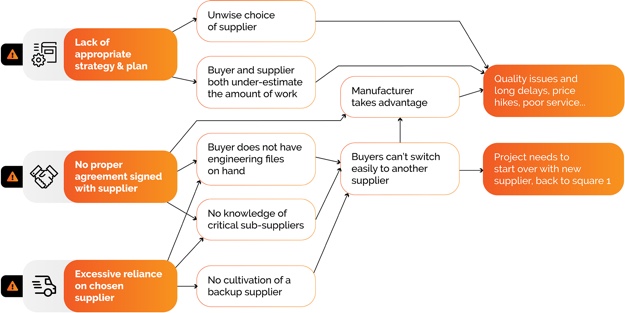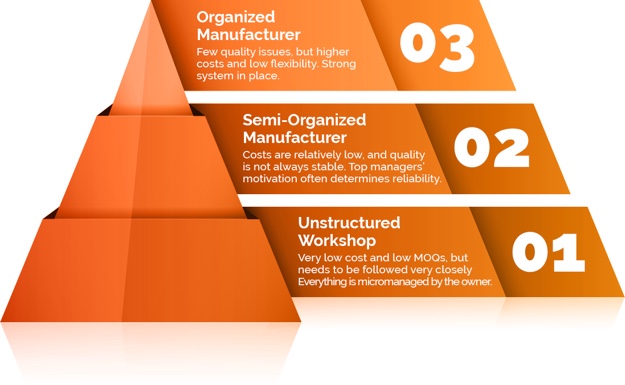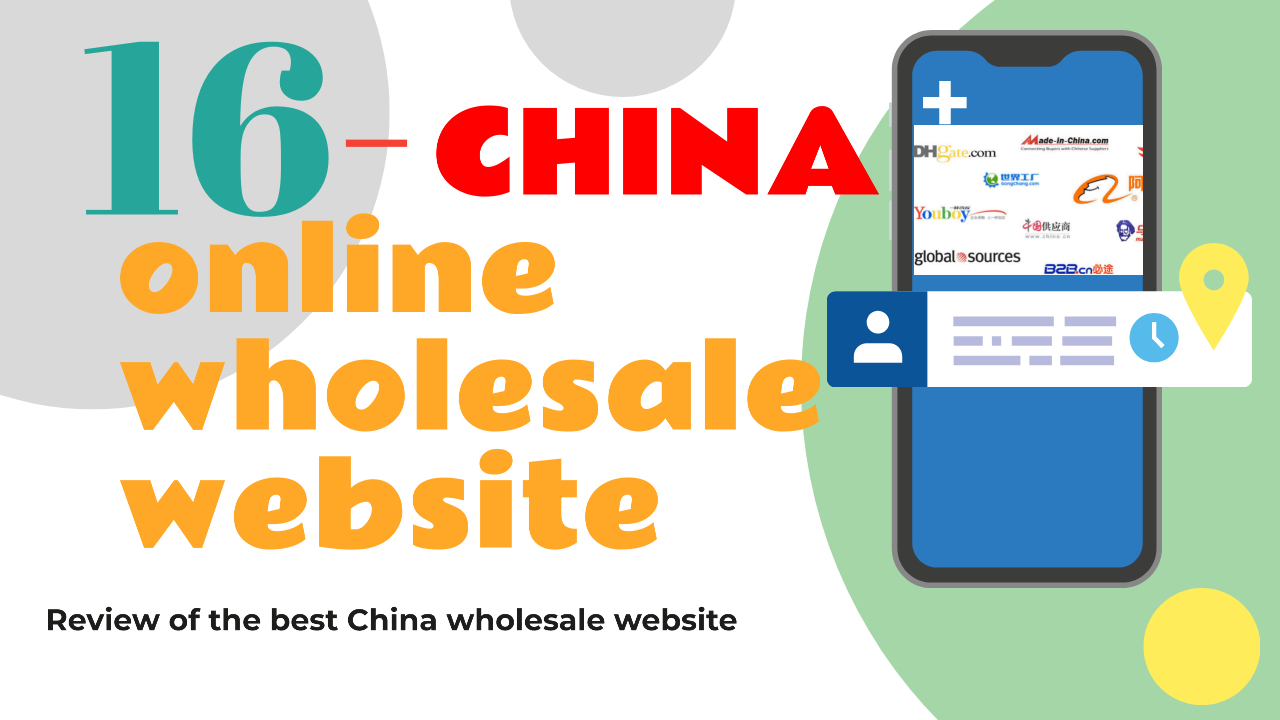How to Outsource Manufacturing to China?
Are you designing or developing a new product that will be manufactured in China? Unless you have been doing this professionally for years, it can be a very challenging experience.
I have been working with companies in your situation for over 10 years and this guide may be right for you. It won’t give you an exact map because there is no such thing. It will warn you about the 3 main pitfalls you need to avoid and a list of “best practices” that the best companies should follow.
Everything in this guide is written from the perspective of a startup or SME launching a new product. Nothing here is out of your reach (or “only for big companies”).
Table of Contents
Benefits of Outsourcing Manufacturing to China?
Big companies that sell a lot in the US are moving some of their proven products to Vietnam, Malaysia, Thailand, etc. That’s right. True. But let’s say you want to develop new machinery or electronics quickly and remove all unnecessary obstacles.
In this case, you will most likely need to manufacture a product in China for the following reasons.
- – You will be close to a wide range of component suppliers, surface treatment facilities, etc.
- – The tooling can be manufactured quickly and (relatively) cheaply.
- – human resources, especially expertise in different technologies and processes, seem to be unlimited.
- – China’s infrastructure and its network of service providers are unparalleled in Asia.
3 Fatal Mistakes That Will Hurt Your Ability to Effectively Manufacture a Product in China:
This section could be titled “The domino effect of manufacturing products in China.” Making 2 or 3 critical mistakes at the beginning of getting a product manufactured in China can often lead to a host of other serious problems. I recently looked at the millions of dollars wasted on Coolest Cooler, a Kickstarter project that failed miserably.
I discussed this topic with people who confirmed my observation that the same types of problems tend to plague companies developing and manufacturing a product in China. They are usually caused by a few mistakes made early in the process. Here’s how it usually unfolds.
Fatal Mistake 1. Not Having a Proper Strategy and Plan
This usually leads to companies falling into the hands of the wrong type of supplier. The following are some examples.
- – Partnering with ODM manufacturers because they already have relatively similar products… Taking the risk of being the source of your own new product ideas
- – Working with a trading company that may not have much control over what happens in the factory
- – Working with a large organization that will never devote its best resources to your (small) project
- – Working with a manufacturer that doesn’t even have the right engineering capabilities
Many companies come to us after becoming frustrated with an unsuitable supplier. We have noticed that this original mistake is often the root of many other problems:
- -Excessive trust in one supplier and the lack of a backup supplier become a huge problem when it is time to end the current relationship (which I will cover later). It is important to cultivate backups for any project other than a small one. Even if you are not 100% production-ready, they should be at least half.
- – Ignorance of the huge gap between R&D (a few prototypes of a product made with components from random suppliers) and NPI (certified products, off-the-shelf tools, off-the-shelf production processes, off-the-shelf test stations, qualified suppliers, and the ability to transition smoothly from product development to volume production). Because it is ignored, even bridging this gap can take up to 6 months of hard work!
- – Since the buyers had no realistic judgment of a successful (i.e. largely problem-free) mass production run, they made three serious mistakes.
-
- Believing the supplier’s optimistic projections (which often turn out to be overly enthusiastic) without asking for a concrete plan and challenging it. Yes, of course, it can be shipped in 3 months…
- Promising to go to the market to eager retailers and/or crowdfunding backers at unrealistic dates and delaying delivery by 6-18 months!
- Promising the market and investors a certain product before the product design has really matured. What if the material eventually needs to be changed to make it mass manufacturable? And a part of the software that has to be certified?
Fatal Mistake 2. Not Signing the Proper Agreement at the Beginning of the Relationship
A proper agreement is critical, but it is often put on hold and forgotten … until buyers begin to suspect (or obvious signs of misconduct). Here are some of the key advantages it will provide.
- – Get the supplier to commit to keeping the bill of materials (i.e., the list of all components and their sources and prices) open to you. Some manufacturers will accept this if you ask for it from the outset.
- – Make the supplier aware that all developed intellectual property is yours. Yes, this should be “normal,” but in China, it is not …
- – Leverage in the event of supplier misconduct. This applies if you make the agreement enforceable in the supplier’s country. Get to know China’s manufacturing law as much as possible.
The most important thing is to do this at the beginning. Once you start to get a product manufactured in China and you’ve put in some time, they’ve made some progress and they know you’re not going to leave them. Good luck getting them to sign your agreement at that stage… It’s often too late.
What happens in this situation? It doesn’t always happen, but the supplier may raise the price. Or they may offer poor quality. Or they may take your tools and/or products hostage when you start threatening them with fines.
These situations have killed thousands of new product manufacturing projects. Don’t be one of these casualties. The solution is well known and requires only minor adjustments to apply to your situation.
Fatal Mistake 3. Over-Relying on Your Chosen Supplier
Because you tend to rely on your manufacturer and delegate the entire project to them, you take no precautions.
(This is in addition to the lack of proper protocols, which exacerbates the effects I mentioned above.)
The most common symptoms of this mistake are as follows.
-
- – The buyer does not know the critical component supplier (or the plant that performs the critical surface treatment (e.g. plating, painting, etc.)). This makes switching to a new supplier more difficult, as everything must be started from scratch.
- – There is no (micro) management of engineering work. The buyer has no drawings, schematics and other non-recurring engineering deliverables. Again, leaving the current supplier means starting from scratch!
This is the core of our company’s work and many importers come to us for this type of work. Unfortunately, when they realize how little information they have on hand and how bad their alternatives look, they sometimes decide that their only viable solution is to try to salvage their current supplier relationship …
This decision drives them deeper into their hole. Sometimes they find a way to bring some products to market and get some oxygen. However, they are often digging the graves of their own projects. It’s often wiser to admit failure when they run out of money and have no clear path forward.
How to Outsource Manufacturing to China?
If you think that the random supplier you encounter is likely a risk, you will take more precautions. This is the right mindset to have when doing business in China.
And to mitigate such risks, the first step is to determine the type of “ideal supplier” you need to find, which brings us to the next point: How to have a product manufactured in China?
1. Develop a Smart Strategy and Realistic Plan
Are you excited about a new product concept, eager to see it come to life, and afraid that your competitors will enter the market before you do? Beware of the “rushed entrepreneur” syndrome. As I wrote above, you are about to explore the quasi-unknown territory. You need first to gather some information about your expectations. Don’t rush yourself into trouble that could (and should) be avoided.
Consider all aspects and implications of product design
What causes the most delays? It is too late in the process to fix the problem. Problems are 10 times more expensive and time-consuming if you find them during the prototyping process rather than during the initial design or in production rather than during prototyping.
The following are some examples of important considerations that are often skipped early on but at a high cost.
- – Do you need a level of finishing similar to Apple products? Don’t choose a manufacturer that works primarily for Walmart.
- – Will the retail package come together? This means the packaging needs to be sturdy enough.
- – Does the user expect the battery to be fully charged within 1 hour? This will have an impact on the charger, battery type, etc.
- – Do users expect to be able to replace parts? You need to make this operation easy and consider potential safety issues.
Spend some time planning your next steps
Remember Dwight Eisenhower’s famous quote, “Planning is useless, but planning is essential. Have you ever thought about the different steps of your project, all the way up to “the first batch has been made and shipped out of China”?
People with no experience in product development systematically underestimate the amount of time and effort required. Here are two examples.
- – Electronics design experts will tell you that at least 3 prototypes (for enclosures and electronics) are needed. Each iteration takes time.
- – If your product will not fail prematurely in the hands of users, then you will need to run highly accelerated lifecycle testing (HALT). This is an additional cost, and you may need to wait for the results before confirming the product design.
That’s why last year, we presented a roadmap for complex hardware products developed and manufactured in China. It’s not exactly optimistic, but it will get you thinking about what you might do right or wrong (that’s the point). Work with people who have done it before to adapt this plan to your specific situation.
Are there any milestones?
In your plan, you may want to include milestones, ideally a phased approval process (review before moving on to the next phase).
Note: This is common in established organizations and certain startups that need to convince investors; in most startups, it is usually not formally addressed.
The following are examples of classic milestones.
- – Confirmation that the industrial design (i.e., the external appearance of the product) is attractive to the typical consumer (and/or retailer) prior to detailed 3D work
- – Drawings
- – Confirm that a similar looking prototype is attractive to the typical consumer (and/or retailer)
- – Confirm that proof-of-concept prototypes successfully perform the 2 core functions
- – Confirm that similar working prototypes meet the required specifications
- – Obtain third-party product certification to comply with relevant regulations
Expect some delays
The sad reality is that most projects are delivered late. And, the more complex the project, the more likely they are to fall behind schedule. Many studies show this to be true.
In this article, we show a typical example (the project actually took twice as long as planned). Psychologists call this tendency the “planning fallacy. You may not be able to escape it.
Consider this when preparing your financial projections – every fixed cost (e.g., monthly salary) adds up to a spike in your overall costs. In this sense, paying for services rendered, rather than hiring full-time staff, usually reduces the risk of the project.
There are often solutions that can save time… But they can be high-risk
The following are some examples of time-saving initiatives.
- If you’re not sure about compliance, you can lab test components before production and wait for the results. Or you can risk going directly in production.
- A small trial run prior to volume production is useful for capturing any problems in the process, sometimes even in incoming components. You and the factory may decide to go straight to mass production with the risk of incurring a lot of rework, scrap material, and shipping delays.
- Your prototypes may contain parts from untested suppliers. Finding and qualifying quality suppliers can take time. Again, you and the factory may decide to take the risk of quality problems with your first components.
I hope you have read the beginning of this article. The “3 Fatal Mistakes” I mentioned above are the absolute pitfalls you need to avoid.
You also need to know what the biggest risks and assumptions are in your project. Here are two examples.
- – If you assume that a particular technology can be used for the purpose you have in mind, and if this is very uncertain, then the first thing to do is to use proof of concept to address that assumption.
- – If you believe that the risk of being copied is highest, consult with an attorney who works in IP and is familiar with the Chinese business environment before discussing your product idea with others. On the other hand, it would be very inefficient for you to visit ten companies in Shenzhen without telling them what you need to do.
In particular, spend some time mitigating market risk
As consultant Eric P Rose advises hardware startups, you should make sure there is a demand for your product, and you should understand the nuances of that demand before you invest a lot of money and effort into making that product a reality.
Studies show that 42% of startups fail because they offer something that the market doesn’t value. This is actually the number one reason for launch failure!
In addition to market research, one way to limit market risk is to develop a “minimum viable product” as version 1.0 of your product.
- – Show your target users/buyers virtual (computer design only), physical “look-alike” and physical “work-alike” prototypes to get feedback in the process and make adjustments as necessary
- – Get to market faster with a simpler product, get real-life feedback, and make informed decisions about what’s in version 1.1… Or 2.0!
What certifications are required for the country/region of sale?
You need to know this from the start, and it may take some research.
For example, many of the electronics we develop for our US customers require FCC and sometimes UL certification. This must be planned from the initial design stage:.
- – Placing components on the PCB in the wrong way can lead to FCC failure (in our experience, conducting design reviews and simulations has proven invaluable);
- – If you develop a mobile power supply and the retailer requires it to be UL certified, it is a good idea to spend some time looking for a battery supplier that has already obtained the same UL certification.
- – The certification needs to be done on pre-production prototypes after the tooling has been processed and almost all of the engineering work has been done. Redesign at that stage can be both expensive and time-consuming.
How Do You Choose a Manufacturer in China?
You need to find the right type of supplier for your needs. One way to classify suppliers is based on their business model.
- -Original Design Manufacturer (ODM) – if you want to leverage their existing technology, keep your investment low, and act more like a distributor than a product owner.
- -Original Equipment Manufacturer (OEM) – if you don’t mind working the “Chinese way,”: the supplier hides some of their elements and then develops the product for you according to your design. The OEM specializes in buyers who need to buy such types of products.
- -Contract Manufacturer (CM) – If you are ready to pay for development and tooling and have a clear contract, this can provide you with much control and visibility. You’ll be fighting 3 battles with CM and they might work against each other:
1. Getting the CM to understand your product and figure out how to produce it.
2. Figuring out what troubles or issues the CM might have with the manufacturing and assembly of your product in China.
3. Getting the right price for the each component.
Another way to go is by their size. I usually divide them into 3 main categories.
- -Smaller plants may be “light” in terms of engineering resources and quality control.
- -Larger organizations tend to be slower and more expensive. Finding the “best fit” can take some work. What is the most appropriate process for prototyping custom-designed parts (if any)?
- -Traditional CNC machining, 3D printing, or more common methods such as stereolithography, selective laser sintering or vacuum casting? This information can drive your search for the best partner for initial prototyping. Typical Chinese factories usually do not have such processes in-house but can help with post-prototyping. We will discuss this in more detail in “Elements of Solution 4”.
2. Build Your Supply Chain on a Solid Foundation
Your new electromechanical products may contain dozens of components. In many cases, the success or failure of a development project lies in a series of mistakes when building the supply chain.
Here’s how to avoid them.
Identify, screen, and qualify suppliers. By now, you have the ideal type of supplier. You may have thousands of options in your product category, so you need to filter them down.
First, make sure you are not dealing with a trading company that pretends to own and operate a factory. Business registration checks are quick and easy and can help you clear these.
You also need to make sure they are doing a good job at increasing production. Conduct process audits on one or two key factories. Engineers can visit them and look for risks in the most important areas.
In-depth conversations and keen observations are also important. If the owner was once a salesperson and had been reinvesting profits in real estate, these are usually not good signs.
Never let the middleman obscure visibility
Don’t let an assembly plant build and “own” your entire supply chain.
- -If one of the component suppliers has quality issues, those issues may never be resolved well and you will not be able to send a good engineer.
- -You will know very little about the profitability of the assembler. We’ve seen it in the 60% to 80% range.
- -Assemblers may raise prices and/or under-deliver, and you may have trouble rebuilding your supply chain. For example, you do want to maintain the same anodized finish on the product surface, but most anodizing shops can’t reproduce it.
Don’t try to control every aspect of the supply chain
Some suppliers are critical, and some are not. You don’t have unlimited resources to allow your manufacturer to choose suppliers for screws, connectors, etc.
However, you need to identify a few key rows in the Bill of Materials (BOM).
- -If the material comes into contact with food, you need to ensure that its
- supplier is aware of regulatory requirements.
- -If the housing is made of injection-molded plastic, you need the factory to be able to provide consistent quality.
- -If glues are involved and could create serious problems, you will need MSDSs.
Provide backups for each key supplier
This may not be possible when you develop your product and first order. However, you will need to think about it at some point.
It’s also helpful if your order volume recovers faster than expected – that’s










https://www.supplyia.com/china-wholesale-website/
[…] Importer’s Guide on How to Manufacture a Product in China […]
[…] had created a How to manufacture a product in China guide for entrepreneurs, hardware startups, and SMEs that gives you advance warning about the 3 […]